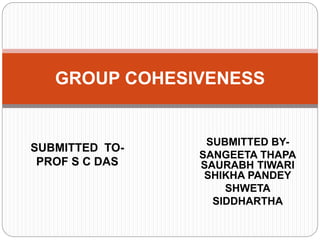
group cohesiveness
- 1. SUBMITTED BY- SANGEETA THAPA SAURABH TIWARI SHIKHA PANDEY SHWETA SIDDHARTHA GROUP COHESIVENESS SUBMITTED TO- PROF S C DAS
- 2. Group •A Group can be defined as a collection of individuals working in face-to-face relationships to share information and resources for a task to be achieved. •The main function of a group is to exchange task- related information and discuss task related issues.
- 3. Stages of Group Development Forming- In the forming stage a lot of uncertainty persists about the group’s purpose, structure and leadership. They like to keep things simple and avoid any controversy. Storming- The storming stage is characterized by the domination of few members, as a result of which some members remain completely passive. Norming- In the norming stage, group members begin to resolve differences and clarify the purpose of the group and roles of the group members. Performing- The performing stage is marked by interdependence in personal relations and problem solving. Adjourning- Adjourning involves the termination of task behaviors and disengagement from relationships.
- 4. What is group cohesiveness? Group cohesiveness is the ability to think and act 'as one' if the group is physically together or not. A group is said to be in a state of cohesion when its members possess bonds linking them to one another and to the group as a whole. According to Stephen P Robbins, “Group cohesiveness is the degree to which members are attracted to each other and are motivated to stay in the group.” Cohesion grows out of communication and common interest Builds group identity Creates climate of inclusion for all members
- 5. Dimensions of group cohesiveness Group Unity Attraction Team work
- 6. Group unity Many theorists believe that group cohesion results from a deep sense of “we-ness” or belonging to a group as a whole. By becoming enthusiastically involved in the efforts of their group and by recognizing the similarities that exist among group members, individuals tend to develop a close connection with their group and its members.
- 7. Attraction According to Hogg (1992), group cohesiveness typically develops from a depersonalized attraction to group members based on their status as group members, rather than a personal attraction based on specific relationships.
- 8. Team work Some theorists stress that cohesion comes from group members’ commitment to work together to complete their shared tasks and accomplish their collective goals. Members of task-oriented groups typically exhibit great interdependence and often possess feelings of responsibility for the group’s outcomes.
- 9. FACTORS CONTRIBUTING TO GROUP COHESIVENESS Threat & Competition COHESION Time Together Previous Successes Difficulty in Entry Group Size Similarities of attitudes and values
- 10. 1. Threat & Competition Whenever the common group goal is threatened, cohesiveness increases. Also, such cohesiveness increases the importance of the goals. When we fight for a goal, the goal gets the highest priority. Thus the threatening party will have less chance of success when faced with a unified force.
- 11. 2. Difficulty in Entry Some groups are not easy to join. The members are very carefully selected and the selected members feels a sense of pride and accomplishment. The more difficult it is to get into a group, the more cohesive that group becomes. The reason being that in exclusive and elite groups the members are selected on the basis of certain characteristics and these characteristics being common to all add to the degree of liking
- 12. 3. Time Together It is quite natural that the more time people spend together, the more they will get to know each other and more tendency there will be to get closer to each other, thus strengthening the degree of cohesiveness. In an organizational setting, people who work near each other are more likely to spend more time together.
- 13. 4. Group Size Since continuous and close interaction among members is a fundamental necessity for cohesiveness, it would be natural to assume that large groups restrict the extent of communication and interaction with each other, thus resulting in reduction of degree of cohesiveness.
- 14. 5. Previous Success When a group achieves a meaningful goal, the cohesiveness of the group increases because the success is shared by all the members and each one feels responsible for the achievement. For example, when a sports team wins an important game, every one in the team congratulates every other member of the
- 15. 6. Similarity of Attitudes & Values One of the strongest source of group cohesiveness is the similarity in values, morals, beliefs and code of conduct. We enjoy the company of others who hold similar opinions and characteristics as ourselves.
- 17. BENEFITS Increased morale Increased productivity Improved communication Conformity and influences
- 18. Disadvantages Clash of personalities Conflict of task Breakdown in communication Struggling for power Frequent turnover of members Disagreement
- 19. HOW TO INCREASE COHESION? Make the group smaller. Encourage agreement with group goals. Increase time members spend together. Increase group status and admission difficultly. Stimulate competition with other groups. Give rewards to the group, not individuals. Physically isolate the group.
- 20. HOW TO DECREASE COHESION? Induce disagreement in group goals. Increase membership heterogeneity. Restrict interaction among members. Increase group size. Allocate reward to individuals rather than to a group as a whole. Remove physical isolation. Introduce a dominating member
- 21. Conclusion Group cohesion has been linked to a range of positive and negative consequences. People in cohesive groups are confronted with powerful pressures to confirm to the group’s goals, norms, and decisions. Cohesiveness leads to the improvement in productivity and efficiency of individuals as well as groups.
- 22. “Talent win games, but teamwork and intelligence wins championships” - Michael Jordon If you want to go Fast, go alone. If you want to go Far, go together. Individually we are one drop but together, we are an ocean. - Ryunosuke Satoro
- 24. REFERENCES Udai Pareek’s Understanding Organizational Behaviour 3rd edition http://www.managementstudyhq.com/group- cohesiveness.html Google.co.in/search http://www.tusculum.edu/faculty/home/tmcfarlan d/ppt2/BUSN312- McFarland/ch08_files/frame.htm
